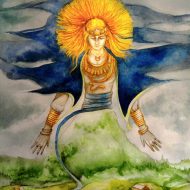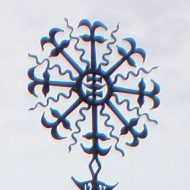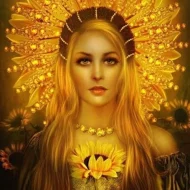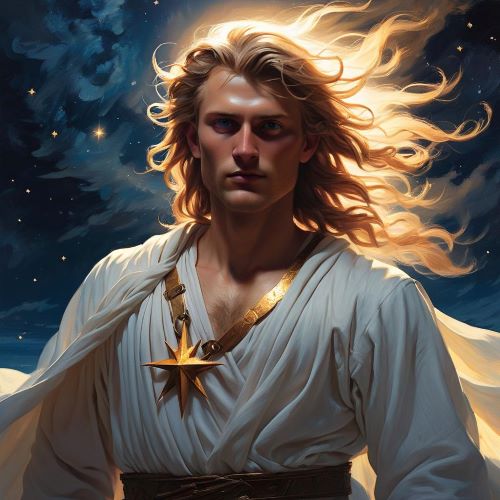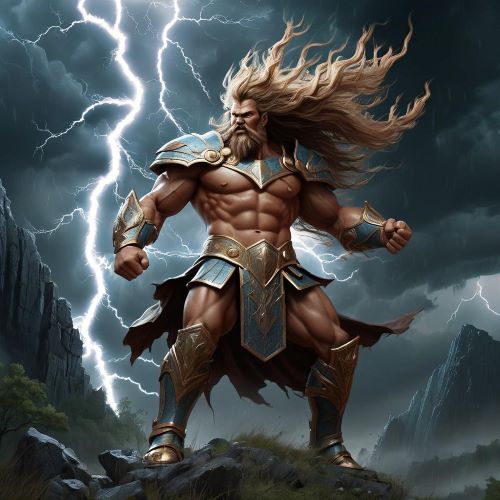Saule : The Sun Goddess
Listen
At a glance
| Description | |
|---|---|
| Origin | Baltic Mythology |
| Classification | Gods |
| Family Members | Menes (Husband), Žemyna, Indraja, Sėlija, Žiezdrė, Vaivora (Children) |
| Region | Latvia, Lithuania |
| Associated With | Sun, Orphans, Gold |
Saule
Introduction
In Baltic religion and mythology, Saule emerges as a prominent figure—an embodiment of the sun goddess responsible for the well-being and regeneration of all life on Earth. In the fascinating tapestry of Baltic myth, Saule embarks on a daily celestial journey, commanding the heavens from her radiant chariot, adorned with copper wheels. This celestial vehicle is tirelessly drawn by horses that defy exhaustion, rest, and perspiration. As the day wanes, Saule descends to the sea, perched atop a hill, where she meticulously washes her unwavering equine companions while clutching the golden reins in her divine grasp.
Subsequently, she ventures beyond the resplendent silver gates, ultimately retreating to her majestic castle, nestled at the edge of the boundless sea. Notably, Saule holds a special fondness for a seemingly innocuous green snake known as žaltys. Within Baltic folklore, it is considered an auspicious omen to have a žaltys within one’s household, while harming or killing such a creature is believed to invite misfortune.
Physical Traits
In ancient mythology, Saule, often depicted as a resplendent golden-haired figure, held a prominent place among the celestial deities. Draped in regal attire consisting of golden silk, a magnificent shawl, and a majestic crown, she personified the radiant splendor of the sun. Saule’s celestial journey involved her guiding a divine chariot across the heavens, a celestial vehicle drawn by a pair of magnificent white steeds known as Asviniai. These celestial horses were regarded as the offspring of the sky god Dievas, adding an enchanting dimension to the mythological narrative.
Family
Saulė, known as the “mother” of the celestial family, was revered as the progenitor of the planets in ancient Lithuanian beliefs. Among her celestial offspring were Vaivora (associated with Mercury), Ziazdré (linked to Mars), Indraja (connected to Jupiter), Aušrinė (representing Venus), Selija (tied to Saturn), and Zemyna (symbolic of Earth). Interestingly, some historical accounts suggest that Lithuanian tribes had named their planets even before the ancient Greeks and Romans.
On a notable date, December 13th, Saulė marks a significant moment by pausing her celestial journey to engage in a celestial dance with her daughters. This celestial dance is also observed during Velykos (Easter) and Rasa (Summer Solstice) in Lithuanian mythology. Intriguingly, myths surrounding Saulė’s relationships include her marriage to Mėnulis (the moon), which ultimately ended in divorce due to his alleged infidelity with their daughter Aušrinė. In a moment of anger, Saulė is said to have scratched Mėnulis’s face, resulting in the moon’s perpetual presentation of only one side to the Earth. Furthermore, Saulė’s connection extends to the enigmatic blacksmith god Kalvis, who is believed to have crafted the sun and placed it in the celestial realm according to ancient Lithuanian narratives.
Other names
In the Lithuanian and Latvian languages, the noun “Saulė” or “Saule” holds a significant role as it serves as the traditional name for the Sun. This term has its roots in the Proto-Baltic language and can be traced back to the ancient form *Sauliā > *Saulē. This linguistic evolution showcases the rich historical and cultural connections between language and celestial objects in these Baltic languages. In some instances, she was affectionately referred to as “ridolele,” the rolling sun. Latvian songs lovingly described her as “ligo,” which conveys the idea of swaying or dancing, derived from the word “ligot.”
Powers and Abilities
Saulė was revered as the benevolent mother goddess, radiating love and care for all humanity. She served as a powerful symbol of virtue, with virtuous women often being likened to her. In her divine presence, the forces of darkness, including demons and malevolent spirits, would scatter, granting humans a sense of security as they resumed their daily tasks.
In the Latvian tradition, Saulė was symbolized by the red apple, signifying the setting sun. Her sacred companions included horses, the revered žaltys serpents, white cows, white goats, and various birds. The linden tree and the delicate flowers of roses and daisies held special significance as Saulė’s sacred flora. She was intricately linked to the cyclical nature of the seasons and agriculture, often associated with the turning wheel of the year.
In Lithuania, shepherds held Saulė in high esteem, regarding her as their guardian goddess. They composed numerous devotional songs and heartfelt prayers dedicated to her, expressing their deep reverence. Saulė also served as the protector of women, particularly single mothers, embodying the qualities of healing and motherhood. She even had an artistic side, as she was believed to play the kanklės, a traditional harp-like instrument, making her a patron of the arts and music. Across the border in Latvia, Saulė assumed the role of protector for orphaned children and those facing life’s hardships, providing solace and support to those in need.
Modern Day Influence
With the spread of Christianity in the region, worship of traditional gods such as Saule were relegated to paganism and looked down upon. The influence of communism further downplayed the rich mythology of the region. Today, not many people practice worship of the goddess and she has faded into a small portion of the folklore and stories of Latvia and Lithuania.
Related Images
Frequently Asked Questions
What is lorem Ipsum?
I am text block. Click edit button to change this text. Lorem ipsum dolor sit amet, consectetur adipiscing elit. Ut elit tellus, luctus nec ullamcorper mattis, pulvinar dapibus leo.
What is lorem Ipsum?
I am text block. Click edit button to change this text. Lorem ipsum dolor sit amet, consectetur adipiscing elit. Ut elit tellus, luctus nec ullamcorper mattis, pulvinar dapibus leo.
What is lorem Ipsum?
I am text block. Click edit button to change this text. Lorem ipsum dolor sit amet, consectetur adipiscing elit. Ut elit tellus, luctus nec ullamcorper mattis, pulvinar dapibus leo.
What is lorem Ipsum?
I am text block. Click edit button to change this text. Lorem ipsum dolor sit amet, consectetur adipiscing elit. Ut elit tellus, luctus nec ullamcorper mattis, pulvinar dapibus leo.
What is lorem Ipsum?
I am text block. Click edit button to change this text. Lorem ipsum dolor sit amet, consectetur adipiscing elit. Ut elit tellus, luctus nec ullamcorper mattis, pulvinar dapibus leo.

